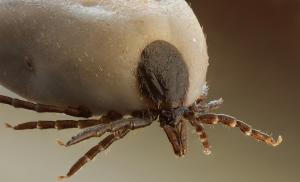
It’s not a Band-Aid, but it looks like one. You stick it on your skin after a tick bite, and it immediately goes to work, detecting and inhibiting the harmful bacteria that causes Lyme disease.
U.S. Air Force Academy students won a gold medal for the big idea at the 2023 International Genetically Engineered Machine competition in Paris.
UVA chemical engineering Ph.D. student Toriana “Tori” Vigil was their adviser. As an instructor and researcher working under a National Science Foundation grant at the academy last fall, she used her knowledge of protein engineering to counsel the cadets on the tech, a biosensor patch called Lyme-AID.
IGEM is the foremost synthetic biology competition and community in the world. The 2023 Grand Jamboree was highly competitive, with 400 teams entering from 50 countries.
“I was happy the cadets’ hard work was recognized,” Vigil said. “I was in the lab teaching and guiding their research, so I could see how passionate the iGEM team was about this project.”

A Critical Health Concern: Lyme Disease in the Field
The Centers for Disease Control estimates about 476,000 cases of Lyme disease occur in the U.S. each year — caused by the bacteria Borrelia burgdorferi, which is transmitted through tick bites.
It’s a serious condition that, left untreated, can progress from flu-like symptoms and rash to severe joint pain, nerve pain, headaches, facial paralysis, and inflammation of the brain and spinal cord. Early detection is essential for the best patient outcomes.
“While tests for Lyme disease exist, the Lyme-AID project aims to make testing fast, user-friendly and independent from medical labs — an important factor for military members in the field,” Vigil said.
The Science Behind Lyme-AID
Here’s how the idea will work once produced:
Lyme-AID is a stick-on bandage filled with a pink-colored solution. The bandage is applied directly to the tick bite. Then a salivary gland protein from the tick loxodes scapularis, which science calls Salp12, attracts the harmful bacteria back to the wound site.
That doesn’t just prevent the spread. If B. burgdorferi bacteria are present and attracted to the patch, a short strand of DNA with gold nanoparticles attached binds to target proteins within the bacteria. The freed particles then cause the pink solution to turn blue, indicating a positive test.
The Lyme-AID project aims to make testing fast, user-friendly and independent from medical labs — an important factor for military members in the field.
The team proved it will all work in theory. They hope to have a prototype of the patch in the next few years.
“It was really affirming to apply my knowledge of genetic and protein engineering to the Lyme-AID project,” Vigil said. “It was exciting to see my skills in action outside of my current research and know that I have many opportunities to make a difference in my career.”
The Lyme-AID team continues to improve its research with Vigil’s support.
Adhering Work From iGEM 2022
During her National Science Foundation INTERN semester, Vigil also spent time with the academy’s previous iGEM team, with whom she has submitted a paper for publishing.
The ongoing collaboration began after those cadets read Vigil’s first-authored paper, “Understanding the Relationships between Solubility, Stability and Activity of Silicatein,” as part of their research, and reached out to Vigil and her advisor, Bryan Berger, an associate professor of chemical and biomedical engineering.
In Berger’s lab, Vigil develops new techniques to reduce the environmental impacts of mining rare earth elements, which are critical to our future energy needs. Wind turbines, solar panels, electric vehicles and storage batteries all require the materials.
Using genetic and protein-engineering, her research borrows from the natural process of biomineralization, in which organisms produce minerals.